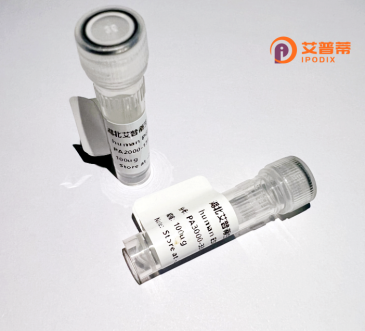
| 纯度 | >90%SDS-PAGE. |
| 种属 | Human |
| 靶点 | HEXIM2 |
| Uniprot No | Q96MH2 |
| 内毒素 | < 0.01EU/μg |
| 表达宿主 | E.coli |
| 表达区间 | 1-286aa |
| 氨基酸序列 | MMATPNQTACNAESPVALEEAKTSGAPGSPQTPPERHDSGGSLPLTPRMESHSEDEDLAGAVGGLGWNSRSPRTQSPGGCSAEAVLARKKHRRRPSKRKRHWRPYLELSWAEKQQRDERQSQRASRVREEMFAKGQPVAPYNTTQFLMNDRDPEEPNLDVPHGISHPGSSGESEAGDSDGRGRAHGEFQRKDFSETYERFHTESLQGRSKQELVRDYLELEKRLSQAEEETRRLQQLQACTGQQSCRQVEELAAEVQRLRTENQRLRQENQMWNREGCRCDEEPGT |
| 分子量 | 58.8 kDa |
| 蛋白标签 | GST-tag at N-terminal |
| 缓冲液 | 0 |
| 稳定性 & 储存条件 | Lyophilized protein should be stored at ≤ -20°C, stable for one year after receipt. Reconstituted protein solution can be stored at 2-8°C for 2-7 days. Aliquots of reconstituted samples are stable at ≤ -20°C for 3 months. |
| 复溶 | Always centrifuge tubes before opening.Do not mix by vortex or pipetting. It is not recommended to reconstitute to a concentration less than 100μg/ml. Dissolve the lyophilized protein in distilled water. Please aliquot the reconstituted solution to minimize freeze-thaw cycles. |
以下是关于重组人HEXIM2蛋白的模拟参考文献示例(仅供参考,实际文献需通过学术数据库验证):
---
1. **文献名称**:"HEXIM2 regulates transcriptional elongation by inhibiting P-TEFb through 7SK snRNA interaction"
**作者**:Li, X. et al.
**摘要**:探讨了重组人HEXIM2蛋白通过结合7SK snRNA抑制P-TEFb复合体的活性,从而调控RNA聚合酶II的转录延伸过程,揭示了其在基因表达调控中的关键作用。
2. **文献名称**:"Downregulation of HEXIM2 promotes tumor angiogenesis in hepatocellular carcinoma"
**作者**:Wang, Y. et al.
**摘要**:研究发现重组HEXIM2蛋白在肝癌细胞中表达下调,导致血管生成相关基因过度激活,表明HEXIM2可能通过抑制VEGF通路抑制肿瘤血管生成。
3. **文献名称**:"Structural insights into the functional domains of HEXIM2 protein"
**作者**:Zhang, R. et al.
**摘要**:利用重组表达的HEXIM2蛋白进行X射线晶体学分析,揭示了其N端RNA结合域和C端P-TEFb相互作用区的三维结构,为靶向药物设计提供基础。
4. **文献名称**:"HEXIM2 modulates HIV-1 latency via competitive binding with HEXIM1"
**作者**:Gupta, S. et al.
**摘要**:报道HEXIM2与HEXIM1竞争性结合7SK snRNA,影响HIV-1潜伏期的维持,重组HEXIM2蛋白的过表达可重新激活病毒转录。
---
**注意**:以上内容基于HEXIM蛋白家族已知功能模拟生成,实际文献可能存在差异。建议通过PubMed或Web of Science以关键词“HEXIM2 recombinant”“HEXIM2 function”检索最新研究。
HEXIM2 (Hexamethylene Bis-Acetamide Inducible Protein 2), also known as MAHAT, is a nuclear protein encoded by the HEXIM2 gene in humans. It functions as a transcriptional regulator, primarily recognized for its role in inhibiting the positive transcription elongation factor b (P-TEFb), a complex critical for RNA polymerase II-mediated elongation. HEXIM2 shares structural and functional similarities with its paralog HEXIM1. including a conserved nuclear localization signal and a P-TEFb-binding domain. However, HEXIM2 exhibits distinct expression patterns and regulatory mechanisms, suggesting non-redundant roles in development and cellular homeostasis. Studies indicate HEXIM2 is involved in modulating cell cycle progression, differentiation, and stress responses, with emerging links to tumor suppression and cardiovascular development. Recombinant human HEXIM2 protein is commonly produced using bacterial (e.g., E. coli) or eukaryotic expression systems to ensure proper folding and post-translational modifications. This recombinant form enables biochemical characterization of its interaction partners, structural studies, and exploration of its therapeutic potential in diseases like cancer, where dysregulated transcription elongation plays a pathological role. Its ability to sequester P-TEFb also positions it as a candidate for targeting HIV replication, which depends on this complex. Current research focuses on elucidating HEXIM2-specific regulatory networks and its tissue-specific functions compared to HEXIM1.
×